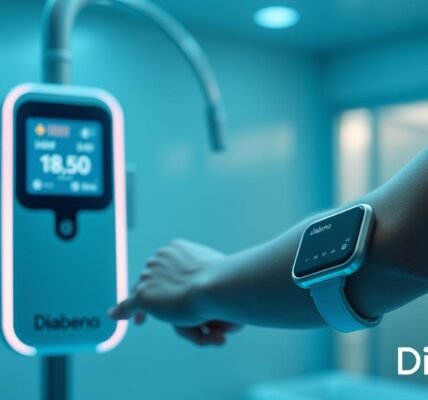Have you ever thought about how machine learning could predict your diabetes risk? With millions affected worldwide, and health spending on diabetes reaching $966 billion in 2021, the need is urgent1. New predictive models are changing how doctors spot diabetes risk, leading to early detection and saving lives2. Researchers use advanced algorithms like random forests and adaptive boosting to find new ways to manage diabetes13.
As diabetes cases are expected to hit 783.2 million by 2045, it’s key to understand these tools2. This article looks into how machine learning tools assess diabetes risk. It shows how they analyze big data to predict risks accurately. Let’s explore how technology and health are teaming up to fight diabetes.
Key Takeaways
- Machine learning is changing how we predict diabetes risk.
- Early detection through predictive modeling can lead to better diabetes management.
- Random forests are among the most effective algorithms for diabetes risk assessment.
- A significant rise in diabetes cases emphasizes the need for advanced prediction techniques.
- Understanding risk factors can empower individuals in their health journey.
Understanding Diabetes and its Rising Threat
Diabetes is a major global health crisis affecting millions. By 2021, about 536.6 million people aged 20-79 had diabetes. This number is expected to jump to 783.2 million by 20454. Changes in lifestyle and urbanization are big reasons for this rise.
There are different types of diabetes, like Type 1, Type 2, and gestational diabetes. Type 1 happens when the immune system attacks insulin-making cells. Type 2 is often linked to being overweight and not moving much. Gestational diabetes affects pregnant women and can harm both mom and baby.
Diabetes causes more than just high blood sugar. It can lead to serious diseases like heart disease, nerve damage, and eye problems. In fact, diabetes caused about 460,000 deaths from kidney disease and 20% of heart disease deaths5. This shows how urgent it is to find ways to prevent it.
The growing number of diabetes cases is a big warning sign. If we don’t do better at preventing and treating it, the number of people with diabetes could reach 430 million5. It’s crucial to tackle the different types of diabetes and their effects to improve health worldwide.
The Role of Machine Learning in Healthcare
Machine learning in healthcare is growing fast. It’s key in AI in medicine for solving big health problems, like diabetes. With almost 529 million people worldwide with diabetes, finding and treating them quickly is critical6. Machine learning looks at huge amounts of data to find patterns. This helps spot diseases early and tailor treatments.

These new tools help manage chronic diseases better. For diabetes, for example, they make healthcare smarter. The Xgboost ML model is especially good at predicting heart disease in diabetes patients, beating old methods7.
Using machine learning can make healthcare better and more efficient. But, it’s important to remember that not all AI and ML tools help patients with diabetes and heart disease6. We need to use these technologies more in healthcare to see real benefits.
Machine Learning Diabetes Risk: An Overview
In recent years, predictive modeling has changed how we predict diabetes risk. Machine learning algorithms for diabetes look at lots of patient data. They make it easier to find who might get diabetes. Techniques like XGBoost help doctors find important signs of type 2 diabetes.
Introduction to Predictive Modeling
Predictive modeling is key in predicting diabetes risk. It uses lots of data from medical checks and health records. This helps find big signs of diabetes risk.
A study with 556,495 samples found important signs like HbA1c, BMI, and waist size. The XGBoost model was very good, with an accuracy of 97.5%. It did better than old methods like logistic regression8. Another study with over 4 million people also showed XGBoost’s success, with an AUC of 0.91229.
Importance of Accurate Risk Assessment
Getting diabetes risk right is crucial for good healthcare. It lets doctors focus on those most likely to get diabetes. Machine learning helps a lot, including with models like Random Forests and Support Vector Machines.
For example, studies found that things like high blood pressure, fasting blood sugar, and age are very important. They help figure out who might get type-2 diabetes9.
| Study | Data Size | Key Features | Model Performance |
|---|---|---|---|
| UK Biobank | 556,495 samples | HbA1c, BMI, Waist Circumference | Accuracy: 97.5% |
| XGBoost Analysis | 4,075,431 samples | Hypertension, Fasting Blood Glucose, Age | AUC: 0.9122 |
Common Machine Learning Algorithms Used in Diabetes Prediction
Machine learning algorithms for diabetes prediction have become more popular. Random Forests stand out because they are very accurate and can handle complex data well. They work well with different types of data, making them useful for many people.
Random Forests and Their Effectiveness
Random Forests combine many decision trees to make predictions. Each tree votes on the final answer. This method is great for big datasets with lots of variables. It’s especially useful in studies with lots of data.
In a big study, random forests were very good at telling healthy people from those with diabetes. They looked at things like age, blood pressure, and glucose levels10
Other Algorithms in Diabetes Risk Assessment
Other algorithms like Support Vector Machines (SVM) and K-Nearest Neighbors (KNN) are also used. They help find risk factors in different ways. Studies show these models use data like health metrics, lifestyle, and family history to predict diabetes.
This variety of methods shows how important machine learning is in healthcare. It helps make better diagnostic tools11.
The Process of Data Analysis in Diabetes Prediction
Data analysis is key to accurately predicting diabetes. It involves collecting and validating data. This process helps in understanding the risk factors for diabetes.
Data Collection and Variable Screening
Starting with good data is crucial for diabetes prediction. Researchers carefully pick the right data points. This ensures the models are trained well, leading to better predictions.
Cross-Validation Techniques
Using cross-validation is vital for model testing. It divides data into parts for repeated testing. This helps in understanding how models perform under different conditions.
Evaluating Model Performance
Checking how well models perform is essential. Metrics like sensitivity and specificity are used. Recent studies show machine learning can be very accurate in predicting diabetes in predictive analytics12.
| Parameter | Value |
|---|---|
| Sensitivity | 0.789 |
| Specificity | 0.934 |
| False Omission Rate | 0.092 |
| Diagnostic Odds Ratio | 66.234 |
| AUC | 0.950 |
Insights from Recent Studies on Machine Learning and Diabetes
Recent studies show big steps forward in using machine learning (ML) for diabetes prediction. They found that different ML algorithms work in unique ways to spot diabetes risk factors.
Comparative Analysis of ML Algorithms
Research has shown that some algorithms perform much better than others. For example, the ADASYN technique paired with the MLP classifier got great results. It scored an F1 of 82.17 ± 3.38 and an AUC of 89.61 ± 2.09, proving it’s very good at predicting diabetes13.
On the other hand, SMOTE with MLP scored an F1 of 79.85 ± 3.91. This shows that while SMOTE is effective, it’s not as good as ADASYN13.
Key Findings from Predictive Analytics for Diabetes Risk
Recent ML studies have shown how well these tools can predict diabetes risk. A multi-layer neural network was found to have a 97% accuracy in classifying diabetes types. This was better than other models in clinical tests14.
Also, researchers found a specificity of 0.95 and sensitivity of 0.97 for diagnosing diabetes mellitus. This makes ML a strong tool for this purpose14.

Identifying Risk Factors for Diabetes
It’s important to know the risk factors for diabetes to prevent and manage it. Genetic predisposition diabetes and lifestyle impacts on diabetes play big roles. Knowing these can help you lower your risk.
Most Common Risk Factors
- Family history of diabetes
- Obesity and high body mass index (BMI)
- Sedentary lifestyle
- Unhealthy dietary habits
- Age and ethnicity
A study with 138,146 participants found key risk factors for diabetes15. Sleeping 9 or more hours a day and not getting regular check-ups also raise diabetes risk15.
Associations with Lifestyle and Genetics
Research shows lifestyle choices greatly affect diabetes risk. Activities, smoking, and diet all impact health. In Japan, certain socio-economic factors like health awareness and insurance type are more important than traditional risk factors like high blood pressure16.
Diabetes affects about 422 million adults worldwide, showing it’s a big health issue16.
Knowing and changing these risk factors is key to a healthier life. It’s crucial to think about both your genes and lifestyle when looking at your diabetes risk.
Machine Learning Applications in Diabetes Prevention
Machine learning is changing how we prevent diabetes. It helps doctors spot risks early and act fast. This can change someone’s health path. It makes predictions better and helps tailor prevention plans.
Early Detection Models
Early detection models are key in finding those at risk for type 2 diabetes. They use algorithms to look at health data to predict diabetes risk. In 2021, 537 million adults worldwide had diabetes, showing the need for quick action17.
These models get better over time by using more data. This helps them predict better and support early prevention.
Impact of AI Solutions for Diabetes Prevention
AI is changing healthcare for diabetes prevention. It lets hospitals quickly look at big data to find diabetes risks. For example, some models are 99.22% accurate, beating old methods1819.
This helps predict and prevent diabetes. It guides personalized prevention plans.

| Model | Accuracy Rate |
|---|---|
| K-nearest Neighbor (K-NN) | 79.6% |
| Bernoulli Naïve Bayes (BNB) | 77.2% |
| Random Forest | Outperformed most algorithms |
| Logistic Regression | Variable performance rates |
| Support Vector Machine (SVM) | Variable performance rates |
Using machine learning in diabetes prevention is crucial. It makes health risk management better. It gives doctors the tools to fight diabetes1719.
Challenges in Implementing Machine Learning Models
Using machine learning in healthcare faces many hurdles. These issues affect how well predictive analytics work, especially for diabetes risk. Key problems include data quality and bias issues, which are vital for reliable results.
Data Quality and Bias Issues
Data quality greatly affects how well machine learning algorithms work. Research shows that clean data leads to almost perfect results20. In healthcare, data bias can lead to unfair outcomes. This is because factors like income and demographics can influence results.
It’s important to validate models internally. Most studies focus on this, but only a few do external validation21.
Regulatory and Ethical Considerations
As AI becomes more common in healthcare, ethical considerations in AI grow more important. There’s a need for clear rules on transparency and accountability. This is crucial because many studies use methods to understand risk predictors21.
With AI helping predict type 2 diabetes, rules need to change. They must ensure AI algorithms are ethical and protect patient privacy.
Success in using these models depends on solving these problems. We need reliable, accurate, and fair healthcare solutions. These should meet the needs of those at risk for diabetes.
Successful Case Studies Using Machine Learning for Diabetes Risk Prediction
Machine learning has made big strides in predicting diabetes risk. It helps doctors spot people at risk early. This can lead to better health outcomes for patients. These success stories diabetes risk models are changing public health for the better.
Modeling Success Stories
A study with 27,050 adults without Type 2 Diabetes showed how it works. They used health records and 111 variables to predict risk. After cleaning the data, they found a simple model was the most accurate, with an RMSE of 0.838. The Random Forest model was close, with an RMSE of 0.84222.
Long-Term Impact on Public Health
The effects of these findings are huge. Diabetes cases are expected to jump from 425 million in 2017 to 629 million by 2045. This is a 48% increase22. It shows we need better ways to predict diabetes risk.
Studies on the Pima Indian diabetes dataset highlight the importance of certain risk factors. They used different machine learning algorithms to improve risk predictions. This shows how crucial these models are for public health23.

The Future of Machine Learning in Diabetes Management
The future of machine learning in diabetes management is looking bright. New technologies and research will change how we handle this chronic disease. Studies show that type 2 diabetes is expected to rise a lot, making it key to develop better predictive tools.
Ongoing Research and Innovations
Researchers are working hard to use machine learning to better diagnose and predict diabetes. They’ve looked at 40 studies on AI for predicting type 2 diabetes21. They’re using both old and new machine learning methods. They’re also looking into using more data types for better results.
Potential Developments in AI and Predictive Analytics
AI is expected to make diabetes care more personal and effective. It’s estimated that 629 million people could get diabetes by 204519. New tools will help spot risks better, making predictions more reliable. Working together, tech experts and healthcare pros could create big changes in diabetes care.
| Aspect | Current Trends | Future Directions |
|---|---|---|
| Data Sources | EHRs, multi-omics data | Integration of diverse data modalities |
| Modeling Techniques | Classical machine learning as dominant | Increased use of deep learning algorithms |
| Predictive Accuracy | Models focus mainly on internal validation | Pushing for external validation studies |
| Health Impact | Growing diabetes prevalence impacting population | Aiming for timely interventions through AI |
These efforts and advancements show a bright future for machine learning in diabetes care.
Why Traditional Methods May Fall Short
Healthcare keeps getting better, but old ways of predicting diabetes are being questioned. Models like logistic regression have been used, but they’re not always right. Machine learning models, on the other hand, might be more accurate in spotting diabetes risk.
Limitations of Logistic Regression Models
Logistic regression is a well-known method for predicting diabetes. But, it has big problems. It assumes a simple relationship between variables, missing the complex links between BMI and diet. Studies with 129,024 people show that better models, like Gradient Boosting and Neural Networks, are more accurate24.
Comparative Performance Insights
Machine learning models outperform traditional ones in many ways. For example, CATBoost reached 82.1% accuracy with an AUC of 0.83 from data on 17,833 people25. This shows that while logistic regression is a good start, it can’t keep up with machine learning’s detailed insights. Machine learning can also find new risk factors, like job status and health insurance, which old methods might miss.

The Role of Health Analytics in Chronic Condition Management
Health analytics is key in managing chronic conditions like diabetes. It uses data to improve care through machine learning. This helps predict and prevent health issues early on.
Studies show predictive analytics boosts patient outcomes. It helps doctors spot at-risk patients and create personalized care plans26.
Integration of ML in Regular Healthcare Practices
Machine learning makes healthcare more proactive in managing chronic diseases. It uses past health data to predict outcomes. This helps allocate resources better and prevent more problems.
Advanced algorithms help doctors respond quickly to health risks. This can lower healthcare costs, which are a big part of the $4.1 trillion spent each year27. By analyzing data from devices in real-time, care can be tailored to improve patient health.
Collaboration with Healthcare Professionals
Working together is essential in using health analytics for chronic condition management. Data scientists and health analysts help doctors make sense of data. This teamwork makes machine learning work smoothly in healthcare.
It leads to better diagnosis and keeps patients involved in their care. Healthcare data analysts are crucial in turning data into useful insights for doctors26.
| Analytics Type | Description | Importance in Chronic Condition Management |
|---|---|---|
| Descriptive Analytics | Analyzes historical data to identify trends. | Helps understand past patient outcomes and patterns. |
| Diagnostic Analytics | Examines causes of past events. | Identifies reasons behind chronic condition developments. |
| Predictive Analytics | Forecasts future outcomes based on data. | Enables early identification of at-risk patients. |
| Prescriptive Analytics | Recommends specific actions based on data. | Guides healthcare decisions for effective interventions. |
These analytics help health systems improve chronic condition management. This leads to better care for patients.
Data-Driven Approaches for Risk Assessment in Diabetes
Using data to assess diabetes risk is key in the fight against this disease. Big data in healthcare helps doctors understand patient risks better. This leads to early detection and prevention, helping manage diabetes risk factors.
Importance of Big Data in Healthcare
Big data is changing healthcare, especially for diabetes risk prediction. It lets doctors analyze huge amounts of data to find patterns. For example, a study showed machine learning can predict diabetes well, improving efficiency and accuracy28.
Using different machine learning models, like Random Forest and SVM, showed great results in predicting risks29. This method helps healthcare systems create better interventions and track progress.
Visualizing Risk with Nomograms and Other Tools
Visual tools, like nomograms, make complex data easy to understand. They show diabetes risk in a simple way, combining various factors into one picture. They use data like waist size, age, and symptoms to give patients personalized risk estimates30.
Doctors can share risks clearly, helping patients understand and engage in their care. This is crucial for managing and preventing diabetes.

Current Trends in Machine Learning for Diabetes Research
Machine learning is growing fast, leading to big steps in diabetes research. New trends show how new methods and tech are making it easier to predict diabetes risk. With over 34 million Americans with Type 2 diabetes, it’s key to understand these advancements31.
Emerging Techniques and Technologies
New machine learning methods, like geographically weighted random forest models, are showing great promise. They beat older methods, helping spot Type 2 diabetes risk factors better31. The number of people with diabetes worldwide is scary, set to grow to 578 million by 203032.
Advanced algorithms are great at handling big data sets. They look at health signs and demographic info.
Predictions for the Next Decade
Looking ahead, machine learning trends point to more personalized healthcare. We’ll see better use of data mining and machine learning for diabetes risk33. Prediction models could get up to 92% accurate, changing how we prevent and treat diabetes33.
This could lead to fewer diabetes problems. It might also push for healthier living and better patient education.
Personalizing Diabetes Care with Predictive Models
Personalized diabetes care is changing how we manage diabetes. Predictive models forecast risks and help create treatment plans for each person. This approach makes care more focused on the patient, leading to better health outcomes.
Customizing Patient Care Plans
Predictive models offer personalized health strategies based on your health profile. For example, AI algorithms can help diagnose diabetes early and target treatments34. These models assess risks based on age, gender, and medical history. A study with 38,379 participants showed how patient metrics can predict diabetes35.
The Role of Patient Education
Patient education is key in personalized diabetes care. It helps you make informed decisions about your health36. Learning about predictive models helps you understand their benefits. This shows how important it is for patients to be involved in their care34.

Conclusion
The global diabetes epidemic is growing fast. Machine learning algorithms in risk tools might help prevent and manage the disease. These tools have shown great accuracy, like the gradient boosting algorithm, which was 95.50% accurate in predicting diabetes risk37.
This could change how we predict diabetes, making it more accurate and based on data. But, there are still challenges. Issues like data quality and consistent healthcare practices need to be solved.
Tracking factors like BMI could help lower diabetes risk. For example, a model showed that lowering BMI could greatly reduce diabetes onset38. So, the future of diabetes management depends on tech and teamwork between healthcare and patients.
The future looks bright for machine learning in diabetes risk assessment. More research and innovation are needed to make these tools better. This will help reduce diabetes cases and improve health worldwide for everyone. By embracing these advancements, we can lead healthier lives and tackle diabetes together.
FAQ
What is the significance of machine learning in predicting diabetes risk?
How prevalent is diabetes globally?
What types of diabetes are commonly seen?
What machine learning algorithms are effective in diabetes risk assessment?
What role does data analysis play in predicting diabetes?
What are common risk factors associated with diabetes?
How can machine learning assist in diabetes prevention?
What challenges are faced when implementing machine learning models in healthcare?
Can you give examples of successful machine learning applications in diabetes risk prediction?
What can we expect for the future of machine learning in diabetes management?
Why might traditional methods like logistic regression be insufficient for diabetes risk prediction?
How does health analytics contribute to diabetes management?
What is the role of big data in diabetes risk assessment?
What are the current trends in machine learning for diabetes research?
How can predictive models help in personalizing diabetes care?
Source Links
- https://pmc.ncbi.nlm.nih.gov/articles/PMC9889616/
- https://pmc.ncbi.nlm.nih.gov/articles/PMC10041290/
- https://www.nature.com/articles/s41746-024-01034-7
- https://pmc.ncbi.nlm.nih.gov/articles/PMC10591058/
- https://www.nature.com/articles/s41598-024-74357-w
- https://cardiab.biomedcentral.com/articles/10.1186/s12933-023-01985-3
- https://bmcmedinformdecismak.biomedcentral.com/articles/10.1186/s12911-024-02678-x
- https://link.springer.com/article/10.1007/s10489-024-05912-1
- https://dmsjournal.biomedcentral.com/articles/10.1186/s13098-023-01112-y
- https://www.frontiersin.org/journals/genetics/articles/10.3389/fgene.2018.00515/full
- https://www.mdpi.com/2071-1050/15/6/4930
- https://pmc.ncbi.nlm.nih.gov/articles/PMC9318204/
- https://bmcmedresmethodol.biomedcentral.com/articles/10.1186/s12874-024-02341-z
- https://pmc.ncbi.nlm.nih.gov/articles/PMC9955149/
- https://www.cdc.gov/pcd/issues/2019/19_0109.htm
- https://link.springer.com/article/10.1007/s12553-023-00730-w
- https://pmc.ncbi.nlm.nih.gov/articles/PMC10378239/
- https://www.mdpi.com/1424-8220/22/14/5304
- https://link.springer.com/article/10.1007/s43674-022-00034-y
- https://dmsjournal.biomedcentral.com/articles/10.1186/s13098-021-00767-9
- https://www.nature.com/articles/s41746-023-00933-5
- https://www.nature.com/articles/s41598-020-68771-z
- https://www.emerald.com/insight/content/doi/10.1016/j.aci.2018.12.004/full/html
- https://rucore.libraries.rutgers.edu/rutgers-lib/72312/
- https://pmc.ncbi.nlm.nih.gov/articles/PMC9690067/
- https://www.park.edu/blog/data-analytics-in-healthcare-transforming-patient-care-delivery/
- https://sequenex.com/blog/the-role-of-predictive-analytics-in-chronic-disease-management/
- https://pubmed.ncbi.nlm.nih.gov/35890983/
- https://www.nature.com/articles/s41598-020-61123-x
- https://bmcmedinformdecismak.biomedcentral.com/articles/10.1186/s12911-019-0918-5
- https://www.buffalo.edu/ubnow/stories/2021/04/ai-diabetes.html
- https://link.springer.com/article/10.1007/s11042-023-16407-5
- https://www.igi-global.com/article/analysis-and-prediction-of-diabetes-disease-using-machine-learning-methods/303943
- https://pubmed.ncbi.nlm.nih.gov/37749579/
- https://www.mdpi.com/2075-4426/12/11/1899
- https://bmcendocrdisord.biomedcentral.com/articles/10.1186/s12902-019-0436-6
- https://www.academia.edu/72572388/An_Assessment_of_Type_2_Diabetes_Risk_Prediction_Using_Machine_Learning_Techniques
- https://medinform.jmir.org/2020/7/e16850/




